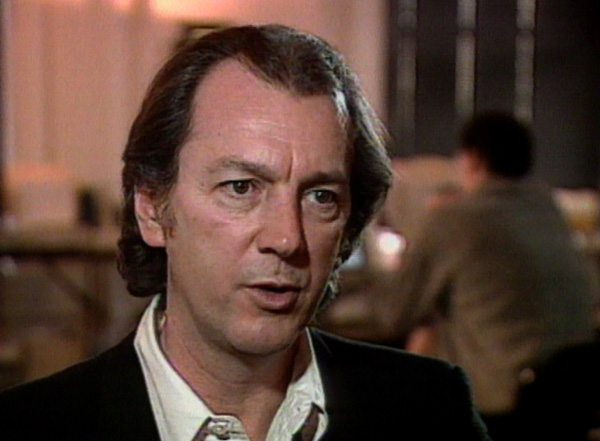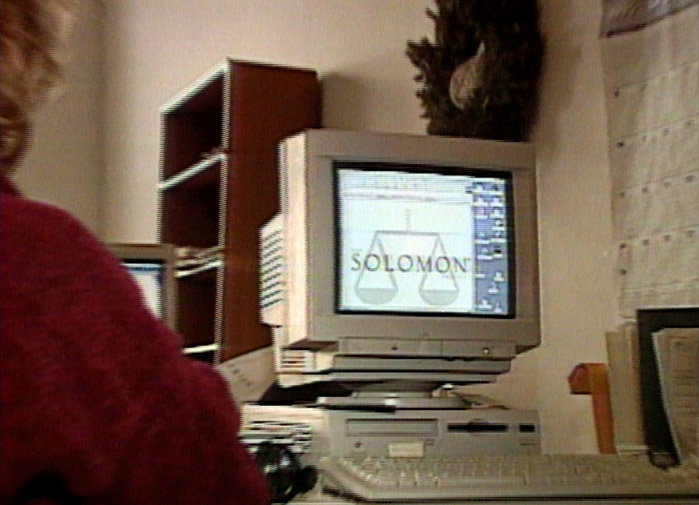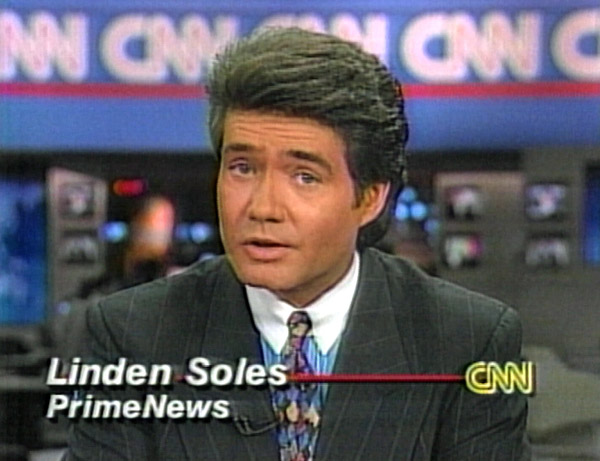Joey Skaggs > Works > 1995, 1996 > Solomon Project

Solomon Project
Year: 1995, 1996
Categories: Law | Politics, Science | Technology
Overview:
“Our legal system was created by guys with buckles on their shoes and curly powdered wigs. It just doesn’t work anymore. I am personally outraged by the fact that criminal and civil court cases are played out before our very eyes as though they were sporting matches. The truth no longer provides the key to justice.” Joey Skaggs
 In October 1995, Dr. Joseph Bonuso, Ph.D. (a.k.a. Joey Skaggs), research fellow and founding director of the Solomon Project, sent out more than 3,000 press releases to elected officials, judges, and law school deans. The release stated that he, with 150 computer scientists and attorneys specializing in artificial intelligence, had developed a solution to the crisis of American jurisprudence. It was called Solomon.
In October 1995, Dr. Joseph Bonuso, Ph.D. (a.k.a. Joey Skaggs), research fellow and founding director of the Solomon Project, sent out more than 3,000 press releases to elected officials, judges, and law school deans. The release stated that he, with 150 computer scientists and attorneys specializing in artificial intelligence, had developed a solution to the crisis of American jurisprudence. It was called Solomon.
Solomon was a distributed program running on a set of super computers that would deliberate on the facts and evidence of a case and deliver a definitive verdict, eliminating the need for juries and radically reducing the role of judges. All witnesses, lawyers and judges would be subjected to voice stress analysis and polygraph telemetry to assure their honesty. This would eliminate inequity in the courtroom due to race, sex, religion, or financial standing. Finally, there would be equal justice for all.
The press release was on a letterhead designed to look like it was affiliated with New York University Law School. It explained that Solomon had successfully re-tried some highly visible recent legal cases, including Mike Tyson, William Kennedy-Smith, Klaus Von Bulow, and Rodney King, and was poised to retry the O.J. Simpson case. O.J.’s lengthy criminal trial had just ended with O.J.’s acquittal. The purpose of the press releases was to solicit comments from highly respected legal pundits.
In November, Dr. Bonuso sent a second press release titled “Here Comes the Judge” announcing a 15-city demonstration tour.
He sent a third press release in December 1995 announcing that Solomon had found O.J. Simpson guilty.
Throughout this three month period the Solomon Project received many letters and calls, both for and against it. Numerous articles were published in legal trade journals, consumer newspapers and magazines. No one realized it was a hoax.
Because they were repeatedly contacted by the media about this project, NYU Law School administrators did some research and discovered there was no actual connection to the school. Their attorneys sent a notice to Joseph Bonuso asking him to refrain from making this claim and he complied in all future correspondence, but the original press release was already in the hands of publications, professors, judges and practicing attorneys, many of whom thought it was a great idea.
In mid December, CNN contacted Dr. Bonuso, requesting a demonstration. The producer told him exactly what they hoped to see and scheduled a time to come. On December 27, Skaggs transformed the 3rd floor of the Voyager Company, a CD ROM publishing group in Soho, into the Solomon Project headquarters.
 He replaced the Voyager sign with a sign for the Solomon Project and mounted graphics, one screen deep, on the many computer screens in the room. Twenty five programmers and computer graphic artists were given parts to play in the drama about to unfold.
He replaced the Voyager sign with a sign for the Solomon Project and mounted graphics, one screen deep, on the many computer screens in the room. Twenty five programmers and computer graphic artists were given parts to play in the drama about to unfold.
Several of Skaggs’ friends who had appeared in or documented other performances, came to help. The CNN crew was unfazed by the appearance of several video crews. This simply helped convince them they were onto something hot. CNN filmed for over an hour and never once appeared suspicious.
 On December 29, 1995, CNN began broadcasting extensive coverage on the Solomon Project on CNN International, CNN Headline News, and CNN Interactive on the Internet [transcript]. On January 30, 1996, they broadcast a lengthy retraction [transcript], having found out the hard way, that they had been had. Unfortunately for CNN, this was not the first time they were found guilty of poor judgment in relation to Joey Skaggs. In fact it was the fifth time a Skaggs piece had been covered on the network.
On December 29, 1995, CNN began broadcasting extensive coverage on the Solomon Project on CNN International, CNN Headline News, and CNN Interactive on the Internet [transcript]. On January 30, 1996, they broadcast a lengthy retraction [transcript], having found out the hard way, that they had been had. Unfortunately for CNN, this was not the first time they were found guilty of poor judgment in relation to Joey Skaggs. In fact it was the fifth time a Skaggs piece had been covered on the network.
Hook:
- Solomon Project press release #1, October 1995
- Solomon Project press release #2, November 1995
- Solomon Project press release #3, December 1995
Line:
- Wisdom of Solomon: the 'fuzzy logic' version, New Jersey Lawyer, November 6, 1995
- New World Justice, SF Gate, November 13, 1995
- Editorial: Give innovation a chance, by Joseph Bonuso, New Jersey Lawyer, November 20, 1995
- Letter to the Editor: 'Solomon Says'...Or How A Computer Will Do Justice, Missouri Lawyers Weekly, November 20, 1995
- No Judge, No Jury, Just Cheap Justice, by Joseph Bonuso, Ph.D., Oregon Defense Attorney, November 1995
- Virtual juries use 'fuzzy logic' to render verdicts, CNN, December 30, 1995
- NYU's Solomon Project Embarks on National Tour, Legal Publisher, December 31, 1995
- Editorial: Cure or Curse?, by Stan Goodrich, Editor, Computing News & Review, December 1995
- Computer revolution closing in on souls, The Orange County Register, January 1, 1996
- Guilty as Programmed, The National Capital FreeNet, January 9, 1996
- NYU Disavows Link To Recently Publicized Computer Jury Project, New York Law Journal, January 11, 1996
- Artificial intelligence in law a nightmare to all, Knight Ridder/Tribune News Service, by Steven Lynch, January 17, 1996
- Legal Grounds: In-house, Erratum, San Francisco Chronicle, January 22, 1996
- Solomon Project sets fifteen city tour, Computing News & Review, January 1996
- The Solomon Project, Pickworld, January/February 1996
- Future Scope: Computers and Judge and Jury, The Futurist, March 1996
Sinker:
- Solomon Project Exposé, January 1996
- Editor's Notebook: People Are Strange..., Law Office Computing, January 1996
- Media: Press, Joey Skaggs, who delights in practical jokes on the press, has got a million of them, by Mark Landler, The New York Times, January 29, 1996
- Online with Stephen Lynch: Curses, foiled again, The Orange County Register, January 29, 1996
- Media are victims of hoax, CNN, January 30, 1996
- Law Reviews: NYU Jury Project: "It Was Only a Hoax", New York Law Journal, January 30, 1996
- Solomon, Artificial Intelligence Project is Hoax, Legal Publisher, January 31, 1996
- Artist's Hoax Ties NYU Law to "Solomon Project", The Commentator, January 31, 1996
- Bar Talk: Too Good To Be True, The American Lawyer, January/February 1996
- Gotcha..., Missouri Lawyers Weekly, February 5, 1996
- Talk of the Town: Jury Tampering, The New Yorker, February 5, 1996
- Live or Memorex? Stating the Obvious, February 12, 1996
- In the Mail: Postscript, The New Yorker, March 11, 1996
- Editorial: Gullibles' Travels-II, Computing News & Review, March 1996
- Chum: Merry Prankster, Red Herring, April 1996
- Trendlines: Unsound Bites, The Fuzzy Truth, CIO, May 15, 1996
- Bylines: Hoaxer Strikes Again, American Journalism Review, October 3, 1996
- If Media Are Clueless, How Bright is the Public?, by John Elvin, Insight, November 11, 1996
- Simpson Press Entourage Ponders Life after Trials: Some Are Glad Saga Is over; Others Doubt It Ever Will Be, by Jennifer Harper, The Washington Times, February 7, 1997
- Selection of the Fittest, By Susan E. Davis, California Lawyer, December 1997
- Justice in the Blood, Time, November 13, 2000
- China develops AI 'prosecutor' that can press charges 'with 97 accuracy', by Jack Newman, Daily Mail online, December 27, 2021